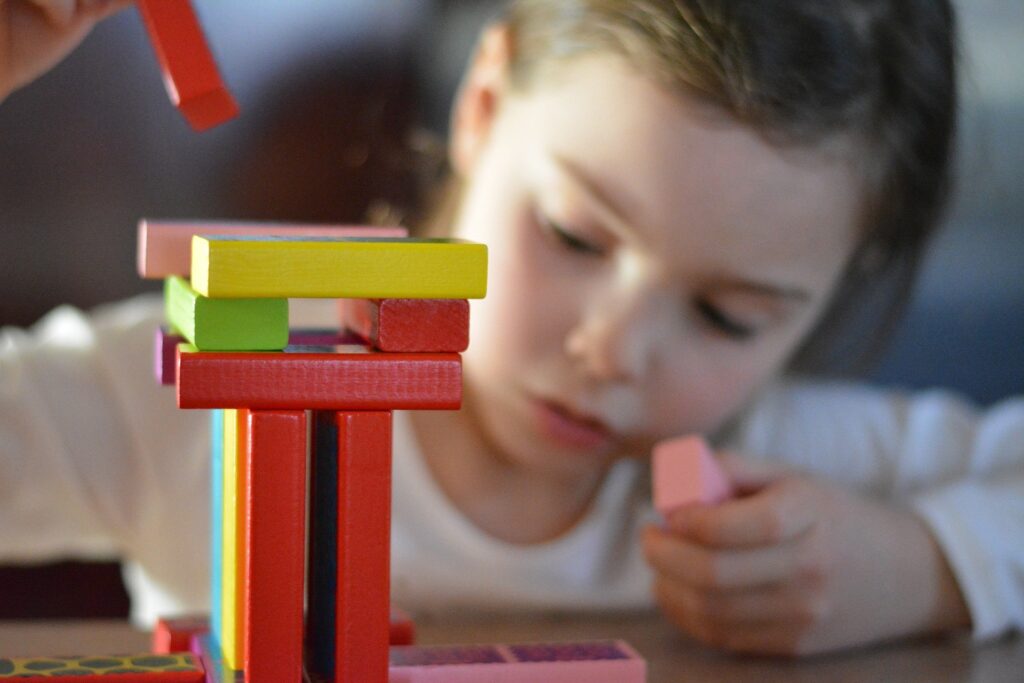Developed by Elaine Dillon
CLASS
Preschool/Infant Classes/First Class
STRAND
Cross-strand content
Here we present the ‘Notice, Explore, Talk about Mathematics’ approach to supporting children’s mathematical development in play and playful activities. We describe the work of a Junior Infant teacher who used the ‘Notice, Explore, Talk about Mathematics’ approach to develop children’s mathematical thinking during child-led play. This approach is in alignment with Aistear, the early childhood curriculum framework and with the overarching aims of the Forthcoming Primary Mathematics Curriculum which aims to aid the development of mathematical proficiency.

Goals of this activity
Through appropriate learning experiences, children should be able to:
- Recognise that mathematics plays a role in their everyday life
- Improve and refine their thinking and communication through engaging in inquiry-based learning opportunities in play.
- Make connections to what they are learning in mathematics with the real world through play.
- Begin to build a productive disposition towards mathematics.
- Develop and apply reasoning to make, assess and justify ideas and conjectures through engaging in logical thought and actions such as analysing, proving, inferring and generalising.
- Investigate and solve a variety of problem-solving situations through play.
- Children become agents of their learning through play which helps them to shape their own sense of identity as capable and competent learners (NCCA, 2009).
- Children are curious about the world and from an early age they are experimenting, questioning and examining the world they live in (Gopnik, 2012).
- Children use play to help them navigate and make sense of their world they are trying to explore (Gray, 2017).
- In play ‘children try out ideas, test theories, experiment with symbol systems, explore social relations, take risks, and reimagine the world’ (Mardell et al, 2016; Brennan, 2014).
- For optimal learning to take place the learning environment should reflect children’s choice, interests and lines of inquiries (Mardell et al, 2016; Edwards et al, 2012; NCCA, 2009).
- Children are likened to mathematicians as they ask ‘deep questions, invent solutions, apply mathematics to solve real problems and play with mathematics’ in everyday activities (Ginsburg, 2006: 158).
- Everyday mathematics is regarded as a substantial feature of children’s play (NCCA, 2020; Stafford, 2012; Ginsburg, 2006).
- Mathematics is illustrated as a language children use to communicate and reason with their understanding of the world around them (Dunphy et al., 2014, French, 2013; Ginsburg et al., 2008).
- Play is valued for providing a rich context that promotes mathematical language. Play offers teachers a space to guide a child in deepening their mathematical thinking in a meaningful context (Dooley et al., 2014; Perry & Dockett, 2007).
- A guided approach to play is outlined as the most effective in terms of mathematical learning in early childhood (Wickstrom et al., 2019; Ginsburg, 2016; Clements & Samara, 2014).
- Guided play is promoted as an effective pedagogy that values child-led play guided forward by an adult. It respects children’s autonomy and encourages pride in their learning. As a result, children cultivate a love of learning by being supported by an adult who guides their learning forward (Weisberg et al., 2016).
- When children play, teachers can encourage them to reason, argue, justify, problem-solve, communicate their trials, errors, and successes (Dooley et al., 2014).
An Approach to Supporting Mathematical development through Play
As part of this approach three types of mathematical play as outlined by Ginsburg (2006) were considered:
- Mathematics embedded in play
- Children make sense of things by using mathematics in their play.
- Play centring on mathematics
- Children play with mathematics directly. They are focused and enjoying counting, creating a pattern, or making the longest train or snake.
- Play with the mathematics that has been taught
- Children recreate ideas and concepts explored in previous mathematical lessons.
The mantra ‘Notice, Explore and Talk about Mathematics (The Smith Family, 2015)’ was adopted and used to make children’s everyday mathematical thinking visible in the classroom.
Notice
- Take time to notice the mathematics that children play with.
- Observe their play.
- Listen to their talk and the language they are using.
- Through observing children’s play, it becomes apparent that mathematics is a substantial feature of children’s everyday play moments.
Explore
- Follow the child’s lead in the play to explore the type of mathematics the children are playing with.
- The aim is not for the children to simply retell or evaluate but to explain and make connections. A teacher’s role is to dig deeper into the child’s thinking and understanding and guide their thinking forward to develop their mathematical understanding.
- A teacher’s strategic and questioning skills are paramount. Open ended questionings, open ended statements or enquiries create space for the exploration of the children’s thinking.
- The teacher’s aim is to support the child to explore, share and connect their mathematical learning to their everyday life.
Talk about Mathematics
- This is a very important step in building a productive disposition for mathematics in young children.
- Teachers play a crucial role in helping the children to build positive dispositions and a growth mindset towards learning mathematics.
- Making the children’s learning visible creates connections for the children between the skills they are learning in mathematics and the purpose they have in their life.
- Celebrating mathematical thinking and mathematical moments builds a productive disposition and enjoyment for mathematics.
